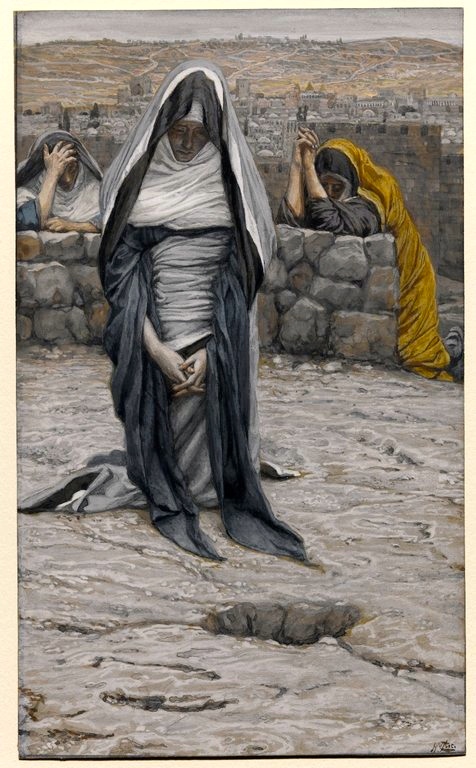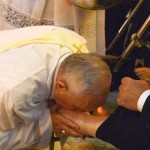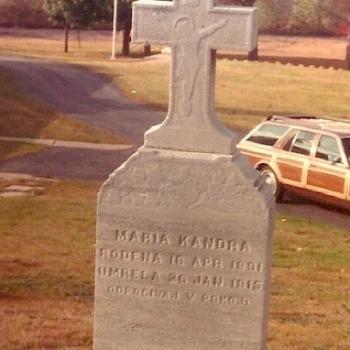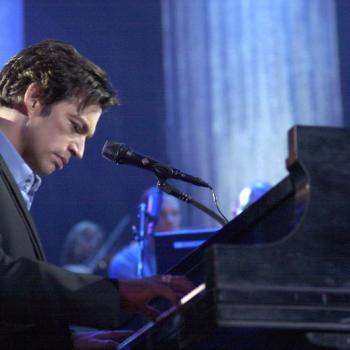About 15 years ago, my wife and I made a pilgrimage to the Holy Land. There, in the Old City of Jerusalem, we walked the Via Dolorosa, the Way of the Cross, passing shops and souvenir vendors selling cards and olive wood crosses. We prayed at the stations, and we encountered many of the sites mentioned in this gospel reading.
But one site in particular stands out in my memory. It is the Church of the Holy Sepulcher—the site of Christ’s passion, death and resurrection.
It is ancient, and hard to navigate. Once you enter, your guide leads you to a dark and smoky chapel, where candles burn and monks pray and incense fills the air. You approach a small place beneath a marble altar, a spot only a few inches wide. You bend down and see a dark hole in the stone floor. Nervously, fearfully you crouch down, reach your hand into the opening and touch a piece of rock—rock worn smooth by almost 20 centuries of hands groping in the dark. The hands of peasants and kings, of saints and servants, all drawn to this very church to do what you are about to do.
And in that moment, you touch one of the most important places in all of human history.
This is the earth that held the cross.
You are touching Calvary.
And for just a moment, the centuries fall away. Here is where the blood fell and women wept. There, just a few inches away, is where Mary stood watch, with John at her side. Nearby were all the others: the centurion, the thief, the guards. Here is where Christ cried out, “I thirst.” Here is where he whispered, “It is finished.” You’re only steps away from where the earth cracked open.
You withdraw your hand from the dark opening and stagger to your feet. The sensation is disorienting. You finally understand that here, at this obscure place, is where everything changed.
Most historians and archeologists agree that this spot is, in fact, the actual site of the crucifixion. To visit Calvary today is to encounter the place where history’s greatest sacrifice was offered—where the Lamb of God was slaughtered, where the Prince of Peace stretched out his arms for the salvation of the world.
This day, in this church, we strive to do what pilgrims have done in Jerusalem for generations: We seek to connect with the mystery of the Passion—this great and unparalleled act of love.
And yes: we seek, somehow, to touch Calvary. We experience it anew. We hear once more the account of Christ’s passion and death. We realize how much he gave, and why.
But if we are honest, we realize something else: that Calvary is not just one place, at one moment in time.
Calvary is everywhere. It is any place where the Body of Christ is scourged, stripped, broken, pierced.
Even now.
There is the Calvary of Ukraine, where Russian soldiers just a few weeks ago slaughtered dozens of Christians in the center of Kiev, many dying with rosaries in their hands.
There is the Calvary of Syria, where Jesuit Father Frans van der Lugt spent 50 years caring for the poorest of the poor. As the civil war worsened, he just could not abandon them. Last week, a gunman broke into the monastery where the priest was living and fired two bullets into his head.
There is the Calvary that dwells within every human heart, whenever we turn toward sin and turn our backs on Christ.
The world is haunted by Calvaries.
But by God’s grace, Calvary isn’t the end of the story.
The great artist James Tissot once painted an image of the blessed Mother that remains one of the most haunting I’ve ever seen. It’s called “The Holy Virgin in Old Age.” It shows Mary at Calvary, many years after her son’s Passion, kneeling before the place which held the cross, gazing into the earth, deep in prayer.
At that spot her son said, “It is finished.” His earthly life ended.
But the Christian story was just beginning.
Twenty centuries later, that very place remains a silent witness to what was—and a testament to what would be.
In Jerusalem, when you go to visit the site of the crucifixion today, as you approach that sacred spot you are struck by something unexpected.
You realize: there is only one way to touch Calvary.
You have to go on your knees.
And: there is only way to move on.
That is by rising.
In this way, the modern pilgrim discovers something as true today as it was two thousand years ago. Here is the overarching message of these holy days—a lesson that holy spot in that ancient church teaches every person who draws near.
The journey to Calvary ends…by rising.













